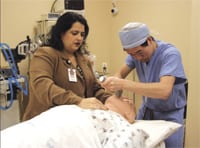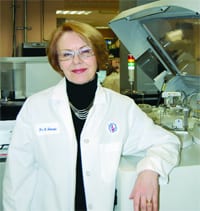Practice Rounds Baystate Simulation Center Benefits Staff, Students Alike
In the life of a surgeon, few moments are as anxious as the first operation, or the first time employing some new laparoscopic or robotic technology.
Fortunately, at Baystate Medical Center, that first time is completely risk-free, because the patient isn’t exactly … alive.
Ask Dr. Rebecca Rhee, a surgical resident who has trained at Baystate for the past five years, and has appreciated the technology available in the hospital’s Simulation Center.
“I found it very useful,” she said of the lab where medical students learn a wide range of techniques, and longtime doctors, nurses, and specialists can hone their skills or learn new ones.
“In surgery, you have to do a lot of reacting in an acute situation,” Rhee added. “Just being able to experience some of the same things you’ll be doing in the operating room or on the patient floor allows you to react with more ease and develop that muscle memory. It helps our education, certainly, but it also helps with overall patient care, and that’s been the most beneficial part of the simulation lab for me.”
The Baystate Simulation Center was launched in 1998, but back then, “it was a small closet with a few box trainers, where you could practice mainly procedural and surgical skills,” said Dr. Gladys Fernandez, instructor of Surgery and manager of Simulation Programs. But the state-of-the-art mannequins that arrived a few years later changed the game.
“In 2005, we got our first high-fidelity patient simulators and started doing the whole gamut of patient care, from the workup to diagnosis to treatment,” she told HCN. Just two years later, the center was accredited by the American College of Surgeons as a level 1 education institute, the 19th in the world at the time, and currently one of only 58.
“Since then, we’ve kept pushing toward pioneering new, innovative methods of teaching in different specialty areas,” she added. “Nurses come in when they need to learn a new kind of IV. Or, when someone is joining the hospital and needs to learn endoscopy, they can train here before doing it on a patient.
“Or we might use it for remediation, to sharpen someone’s skills; when we’ve identified areas requiring improvement, we can do it here safely,” Fernandez continued. “Or if a surgeon has been out for many years and we’re now doing a new type of procedure, they can come here and train.”
Coming to Life
The 4,000-square-foot facility is equipped with a number of cutting-edge (literally and figuratively) mannequins, on which residents perform procedures and track vital signs and other realistic responses. The center also houses a series of virtual-reality simulators on which individuals can operate actual surgical instruments and see the results of their ’work’ in real time on a video screen.
“As soon as we find out a new group of graduates is hired, who will begin working in this institution, we set them up for a series of boot-camp training exposures, where they are tested in essential patient-care skills,” Fernandez explained before ticking off an impressive — but not nearly exhaustive — list of skills they might practice on simulation equipment.
“They learn how to determine if a patient is in a grave condition, how to stabilize a patient, how to put a tube in a trauma patient’s chest who comes in with a knife wound, how to put a large central line in someone, how to sew up a wound in the emergency room, how to navigate minimally invasive surgical tools, how to guide a camera and grab the appendix at the same time, or how to help a surgeon with whatever complicated case he’s working on,” she said.
“During their years here, residents come in and learn endoscopy; they’ll learn complicated surgical skills, whether for open or laparoscopic surgery,” she continued. “They learn robotic surgery as they become more advanced in their training. Over the course of time, they also learn how to examine a patient who has multiple medical problems, who presents with common and uncommon diseases, and learn how to take care of a patient in cardiac arrest.”
It’s not all technology, either, she added; residents actually practice bedside manner on the mannequins.
“They learn appropriate consulation techniques, when to get help, they learn how to break bad news. We teach professionalism and handling ethical questions. As the residents become more advanced, they become teachers, too, with our supervision. Attendings sometimes hone their teaching skills here too, and when there’s a new technique or new device, they train on its use here. Robotic surgery is a good example.”
Rhee said the center made a difference for her, and continues to do so for today’s newcomers to Baystate.
“My first year, at boot camp, the anxiety was there, thinking about all these scenarios of what we might face on the floor,” she said. “This doesn’t immediately take away the anxiety, but by practicing it, it just happens automatically. That’s how surgical skills are developed, the muscle memory. It’s more of a reaction and an instinct than medicine.
“Just in speaking with the attendings,” she continued, “many of them notice a difference when the residents train on different tasks prior to doing surgery with them; they notice it’s easier to perform operations. And it allows the residents to progress more in their education and learn more from a case if they’ve done a simulation prior to doing that case.”
Progress in Focus
Fernandez said the Baystate Simulation Center is similar to multiple centers around the world in that it is intended to help individuals train, maintain certification, and remediate medical staff on cognitive or procedural skills.
“The center underwent reconstruction in 2007,” she said, “and at that point, we expanded to 4,000 square feet and developed an area purely for technical skills training, then developed patient-care rooms that mimic an operating room, an intensive-care unit, an emergency room, a ward bed … we have adult [mannequin] patients as well as pediatric patients, including neonates. We can pretty much provide education to all specialty areas in technical and patient-care skills.”
Those diagnostic skills — assessing a patient’s condition, performing a physical, communicating the data effectively — are often as critical as the technical side, she said. “We can make it one patient or have a full operating room.”
Residents have also uncovered surprising deficiencies by using the simuation equipment — flaws in depth perception, for example.
“One person made a career change because they absolutely couldn’t see what they needed to see in minimally invasive surgery,” Fernandez explained. “It was a perception issue, a true physical disorder, but it had never been tested before because the person never needed to see something like that in a two-dimensional space. We brought it out unintentionally. They stayed in medicine, but not in surgery — and they succeeded.”
Residency is a five-year process, she noted, and having access to this kind of equipment for that long is a huge benefit. “Many years ago, you were learning a new technology on a patient. This is much safer. We have a robotic-surgery simulator; there are only 10 being validated right now in the country, and we’re part of that validation study. It’s a way to teach the da Vinci robotic surgery, which has a steep learning curve. Here, if you make a mistake, we just reboot things” — not exactly an option when dealing with a living, breathing patient.
With simulation technology becoming more common and accessible — and with its benefits so well-documented — it’s no surprise that it is creeping into medical schools (STCC and AIC use mannequins, to name two local examples), and might eventually become standard practice in training programs.
“There is a push toward now starting simulation earlier, not waiting until students have graduated,” Fernandez said. “Medical schools are starting to ramp up these efforts, and a lot of them are affiliated with hospitals or residency training institutions. It is expanding exponentially” — and may soon be mandated by surgical governing bodies.
Certainly it’s common practice for professionals at Baystate, no matter how long they’ve been in practice.
“We have doctors, nurses, advanced-level practitioners, nurse practitioners, physician assistants, and EMTs,” she said. “It’s almost second nature for doctors and nurses to participate in this kind of training; it’s just part of their daily learning.”
And it contributes to a lifetime of confidence — and competence. For anyone about go under the knife in real life, that’s reassuring indeed.




Comments are closed.